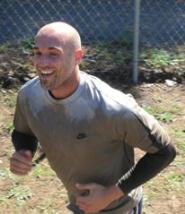Post by Brian Ayers, CSCS on Oct 23, 2008 10:51:44 GMT -5
HIIT is the answer for all of you out there looking to drop some unwanted fat pounds on the cardio machines. I see so many people in the gyms getting on a treadmill or a stationary bike and doing long bouts of cardio at a steady pace. If your goal is to be an endurance athlete that's fine, but if your looking to burn some serious calories then you've got to try HIIT (High Intensity Interval Training). This type of training shakes up your metabolism and promotes a higher post workout fat burn then doing steady state heart rate training.
There are two ways to do cardio intervals. The first way, timed intervals, is easier to measure because it doesn't require a heart rate monitor or knowledge of your max heart rate. Once you've warmed up you simply increase the speed or resistance for a set period of time, it could be a minute or it could be more. Then you work at that higher intensity for your designated period of time, after which you decrease the intensity and work at a recovery level for a set period of time. Some examples would be one min. on and two minutes off, or 30 seconds on and 30 seconds off. A general rule of thumb would be the higher the intensity for the work interval, the longer the recovery should be, unless you are doing a more advanced program.
The second cardio interval method is to do heart rate intervals. For this you need to have a heart rate monitor or be on a machine with a heart rate display. You also want to calculate your resting heart rate. There are many was to do this, the most widely used is 220 minus your age. Then use that number to calculate your theoretical 60%, 70%, 80% and 90% heart rate zones. Once you've warmed up you increase the pace or resistance for a short period of time until you reach a desired high end heart rate (usually 80-90% of your max heart rate) then you reduce the speed or intensity until you've recovered to a desired low end heart rate (usually 65-75% of your max heart rate). When you've recovered to that heart rate zone you then go right back to increasing the intensity until you reach the high end again.
Another benefit to HIIT is that you don't need to spend as long doing it. 30 min. is usually considered to be a long training time for intervals. You can get a good calorie burn doing only 15-20min. Be sure to take a few minutes to cool down afterwards because intervals will create a greater lactic acid production.
There are two ways to do cardio intervals. The first way, timed intervals, is easier to measure because it doesn't require a heart rate monitor or knowledge of your max heart rate. Once you've warmed up you simply increase the speed or resistance for a set period of time, it could be a minute or it could be more. Then you work at that higher intensity for your designated period of time, after which you decrease the intensity and work at a recovery level for a set period of time. Some examples would be one min. on and two minutes off, or 30 seconds on and 30 seconds off. A general rule of thumb would be the higher the intensity for the work interval, the longer the recovery should be, unless you are doing a more advanced program.
The second cardio interval method is to do heart rate intervals. For this you need to have a heart rate monitor or be on a machine with a heart rate display. You also want to calculate your resting heart rate. There are many was to do this, the most widely used is 220 minus your age. Then use that number to calculate your theoretical 60%, 70%, 80% and 90% heart rate zones. Once you've warmed up you increase the pace or resistance for a short period of time until you reach a desired high end heart rate (usually 80-90% of your max heart rate) then you reduce the speed or intensity until you've recovered to a desired low end heart rate (usually 65-75% of your max heart rate). When you've recovered to that heart rate zone you then go right back to increasing the intensity until you reach the high end again.
Another benefit to HIIT is that you don't need to spend as long doing it. 30 min. is usually considered to be a long training time for intervals. You can get a good calorie burn doing only 15-20min. Be sure to take a few minutes to cool down afterwards because intervals will create a greater lactic acid production.





